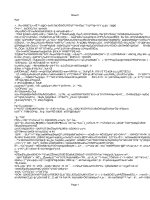marketing princiles unit 5 managing marketing information
Bạn đang xem bản rút gọn của tài liệu. Xem và tải ngay bản đầy đủ của tài liệu tại đây (1.3 MB, 24 trang )
Unit 5
MANAGING
MARKETING
INFORMATION
1
CuuDuongThanCong.com
/>
Objectives
Why marketing information is collected
Key definitions
C
Criteria
ffor valuable information
f
Marketing information and the marketing
process
Qualitative and quantitative research
Quantitative techniques
What users of market research should ask
Legal and privacy issues
2
CuuDuongThanCong.com
/>
The Importance of Information
Companies need
information about their:
Customer needs,
Marketing environment,
C
Competition.
titi
Marketing managers
don’tt need more
don
information, they need
better information.
3
CuuDuongThanCong.com
/>
What is a Marketing
Information System (MIS)?
An MIS consists of people, equipment, and
procedures to g
p
gather, sort, analyze,
y
evaluate,
and distribute needed, timely, and accurate
information to marketing decision makers.
The MIS helps managers to:
Assess Information Needs,
Develop Needed Information,
Distribute Information.
4
CuuDuongThanCong.com
/>
The Marketing Information
System
5
CuuDuongThanCong.com
/>
Functions of an MIS: Developing
p g
Marketing Information
Information Needed by Managers Can be Obtained
From:
Internal Data
Marketing
Intelligence
g
Marketing
Research
Electronic Collections of Information
from Data Sources (i.e. Accounting)
Within the Company
Publicly Available Information about
Competitors and the Marketing
Environment (i
(i.e.
e Technological)
Design, Collection, Analysis, and
Reporting of Data about a Specific
Marketing Situation
6
CuuDuongThanCong.com
/>
Criteria for Valuable Information
Recency
Relevance
R l
Accuracy
Value versus cost
7
CuuDuongThanCong.com
/>
What is an example of marketing
intelligence?
8
CuuDuongThanCong.com
/>
The Marketing Research
Process
9
CuuDuongThanCong.com
/>
Marketing Research Process
Step 1. Defining the Problem & Research
Objectives
Exploratory
Research
Gathers preliminary information
that will help define the problem
and suggest hypotheses.
Descriptive
Research
Describes things
g as market
potential for a product, or the
demographics and consumers’
attitudes.
Causal
Research
Test hypotheses about causep
and-effect relationships.
10
CuuDuongThanCong.com
/>
Marketing Research Process
Step 2. Developing the Research Plan
Research plan development follows these
steps:
t
Determining the Exact Information Needed
Developing a Plan for Gathering It Efficiently
Presenting the Written Plan to Management
11
CuuDuongThanCong.com
/>
Develop the Research Plan
Gathering Information
Both Must
Be:
Information That
Already Exists
S
Somewhere.
h
+ Obtained More
Quickly Lower Cost
Quickly,
Cost.
- Might Not be
Usable Data
Data.
Relevant
Accurate
Current
Information
Collected for the
Specific Purpose
at Hand.
Impartial
12
CuuDuongThanCong.com
/>
Develop the Research Plan
Primary Data Collection
Observational
Research
Gathering data
by observing
people,
l
actions and
situations
(Exploratory)
Research Approaches
Survey
S
Research
Asking
A
ki individuals
i di id l
about attitudes,
preferences or
buying behaviors
(Descriptive)
Experimental
Research
Using groups of
people to
determine
cause-and-effect
relationships
(Causal)
13
CuuDuongThanCong.com
/>
Qualitative & Quantitative
Research
Qualitative
Quantitative
Objectives
j
Discover, scope
p &
Explore
Measure how much, how
many
Format
Spontaneous and
interactive
Logical format
Questions
Unstructured, semistructured, open-ended
and probing
More structured and closed
ended
Responses
Creative
Rational
Analysis
Dependent on researcher Statistical,
Statistical less dependent
Interpretation
on researcher
14
CuuDuongThanCong.com
/>
Develop the Research Plan - Strengths &
W k
Weaknesses
off Contact
C t t Methods
M th d
Telephone
Personal
Online
Flexibility -
Poor
Good
Excellent
Good
Quantity
Q
tit off data
d t to
t be
b
collected -
Good
Fair
Excellent
Good
Control of interviewer
effects -
Excellent
Fair
Poor
Fair
Control of sample -
Fair
Excellent
Fair
Poor
Speed off data
S
collection -
Poor
Excellent
Good
Excellent
Response
p
rate -
Fair
Good
Good
Good
Cost -
Good
Fair
Poor
Excellent
15
CuuDuongThanCong.com
/>
Form small groups of three to five people
and discuss what type of research would
be appropriate in the following situation,
and explain why
why.
Kellogg wants to investigate the impact of
young children on their parents’
parents decisions to
buy breakfast foods.
16
CuuDuongThanCong.com
/>
Develop the Research Plan
Sampling Plan
Sample – segment of
the population
selected to represent
the p
population
p
as a
whole.
Requires 3 Decisions:
Who is to be surveyed?
• Sampling unit
How many people
should be surveyed?
• Sample size
How should the people
in the sample be
chosen?
• Sampling procedure
17
CuuDuongThanCong.com
/>
Develop the Research Plan
Primary Data Collection
Research Instruments
Questionnaire
• What q
questions to ask?
• Form of each question?
•Closed-end
•Open-end
Open end
• Wording?
• Ordering?
Mechanical Devices
•
•
•
•
People Meters
Supermarket Scanners
Galvanometer
Eye Cameras
18
CuuDuongThanCong.com
/>
Marketing Research Process
Step 3. Implementing the Research Plan
Most Expensive & Subject to Error
Collecting the
Data
Processing the
Data
Research Plan
Analysing the
Data
19
CuuDuongThanCong.com
/>
Marketing Research Process
St 4.
Step
4 IInterpreting
t
ti and
d Reporting
R
ti Fi
Findings
di
Researcher Should Present Important Findings
that are Useful in the Major
j Decisions Faced byy
Management.
Step 1. Interpret the Findings
St 2
Step
2. D
Draw C
Conclusions
l i
Step 3
3. Report to Management
20
CuuDuongThanCong.com
/>
Analyzing Marketing
Information
Many companies utilize customer relationship
management
g
((CRM))
Software & analytical tools that integrate customer
information from all sources,
Analyzes it in depth
depth,
Applies the results to build stronger customer
relationships.
Companies look for customer touch points.
CRM analysts develop data warehouses and
use data
d t mining
i i techniques
t h i
tto fi
find
d
information out about customers.
21
CuuDuongThanCong.com
/>
Functions of an MIS: Distributing
and Using Marketing Information
Distributes Routine
Information for
D i i Making
Decision
M ki
Information
f
Must b
be Distributed
b d
to the Right Managers at the Right Time
Distributes Nonroutine
Information for Special
Situations
CuuDuongThanCong.com
22
/>
Other Marketing Research
Considerations
Marketing
Research in
Small Businesses
and
Nonprofit
Organizations
g
International
Marketing
Research
Public Policy
and
Ethics
in
Marketing
Research
23
CuuDuongThanCong.com
/>
Reviewing the Concepts
Explain the importance of information to the
company.
Define the marketing information system and
discuss its parts.
Outline the steps in the marketing research
process.
Compare the advantages and disadvantages of
various methods of collecting information.
Discuss the special issues some marketing
researchers face
face, including public policy and
ethics issues.
24
CuuDuongThanCong.com
/>









